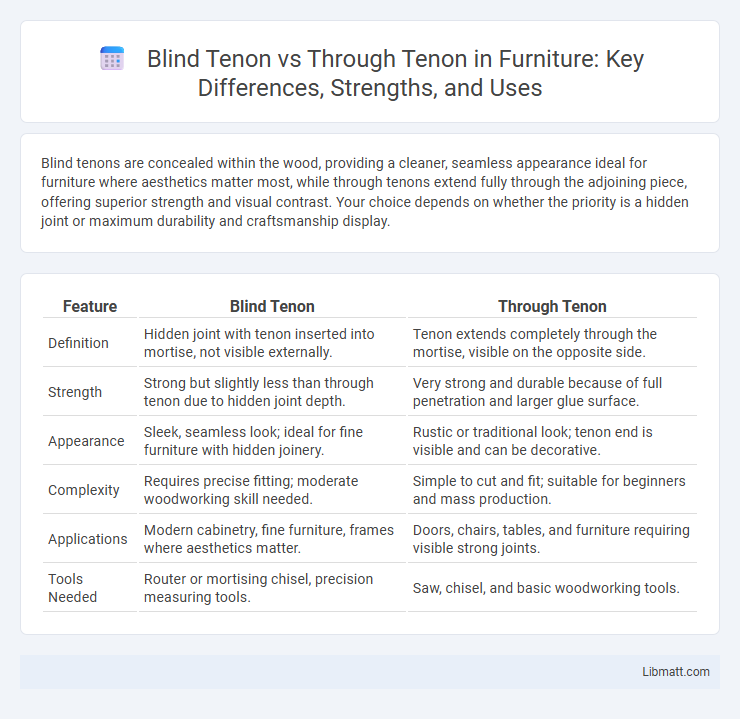Blind tenons are concealed within the wood, providing a cleaner, seamless appearance ideal for furniture where aesthetics matter most, while through tenons extend fully through the adjoining piece, offering superior strength and visual contrast. Your choice depends on whether the priority is a hidden joint or maximum durability and craftsmanship display.
Table of Comparison
| Feature | Blind Tenon | Through Tenon |
|---|---|---|
| Definition | Hidden joint with tenon inserted into mortise, not visible externally. | Tenon extends completely through the mortise, visible on the opposite side. |
| Strength | Strong but slightly less than through tenon due to hidden joint depth. | Very strong and durable because of full penetration and larger glue surface. |
| Appearance | Sleek, seamless look; ideal for fine furniture with hidden joinery. | Rustic or traditional look; tenon end is visible and can be decorative. |
| Complexity | Requires precise fitting; moderate woodworking skill needed. | Simple to cut and fit; suitable for beginners and mass production. |
| Applications | Modern cabinetry, fine furniture, frames where aesthetics matter. | Doors, chairs, tables, and furniture requiring visible strong joints. |
| Tools Needed | Router or mortising chisel, precision measuring tools. | Saw, chisel, and basic woodworking tools. |
Introduction to Tenon Joinery
Tenon joinery involves creating a projecting piece of wood (the tenon) that fits into a corresponding cavity (the mortise) for strong, interlocking connections. Blind tenons are concealed within the wood, providing a smooth, uninterrupted surface ideal for visible furniture pieces. Through tenons extend fully through the adjoining piece, offering increased mechanical strength and a distinctive design element often used in traditional woodworking.
What is a Blind Tenon?
A blind tenon is a type of woodworking joint where the tenon is inserted into a mortise but does not pass completely through the adjoining piece, creating a hidden connection. This technique enhances the aesthetics of your furniture by concealing the joint, offering a clean and seamless appearance. Blind tenons provide strong structural support while maintaining a smooth exterior without visible end grain.
What is a Through Tenon?
A through tenon is a woodworking joint where the tenon passes completely through the mortise, visibly extending out the other side of the wood piece. This type of joint provides exceptional strength and offers a distinctive aesthetic, often showcasing the end grain of the tenon. Through tenons are commonly used in furniture making and architectural timber framing to enhance structural integrity and visual appeal.
Structural Differences Between Blind and Through Tenons
Blind tenons are inserted into a mortise that does not extend through the entire thickness of the adjoining piece, creating a hidden joint that enhances aesthetics by concealing the connection. Through tenons pass completely through the mortised piece, allowing the joint to be visible on both sides and providing superior mechanical strength and alignment. Your choice between blind and through tenons depends on whether the priority is a discreet appearance or maximum structural integrity.
Aesthetic Considerations in Tenon Selection
Blind tenons offer a cleaner, more refined appearance by concealing the joint entirely within the wood, making them ideal for visible furniture surfaces where aesthetics are crucial. Through tenons, while structurally robust, expose the joint's end grain, often serving a decorative purpose in traditional or rustic designs. Your choice between blind and through tenons should balance visual appeal with design intent, ensuring the joint complements the overall style of the piece.
Strength and Durability Comparison
Through tenons provide superior strength and durability due to their full-length engagement, distributing stress evenly across joints in furniture or timber framing. Blind tenons, while offering a cleaner aesthetic by concealing the joint, may have slightly less mechanical strength since the tenon does not extend fully through the mortise. Your choice between these joints depends on balancing structural requirements with visual preferences, but for maximum load-bearing capacity, through tenons are generally preferred.
Applications Best Suited for Blind Tenons
Blind tenons are ideal for applications where the tenon must remain hidden for aesthetic reasons, such as in fine furniture, cabinetry, and intricate woodworking projects. These joints provide strong structural support without visible joinery lines on the surface, preserving the clean look of doors, panels, and frames. Your choice of a blind tenon enhances both the strength and visual appeal of delicate wood assemblies where appearance is crucial.
Ideal Uses for Through Tenons
Through tenons are ideal for applications requiring maximum joint strength and visible architectural details, such as in heavy timber framing, furniture making, and traditional woodworking projects. Their design allows the tenon to pass completely through the mortise, providing superior mechanical stability and an attractive end grain reveal that can be emphasized with decorative pegs or wedges. You will find through tenons particularly effective in load-bearing structures and exposed joinery where both durability and aesthetics are crucial.
Tools and Techniques for Crafting Each Tenon
Crafting blind tenons requires precise use of chisels, routers, or tenon jigs to create a mortise that stops short of the wood's edge, ensuring the tenon remains hidden when assembled. Through tenons demand accurate cutting tools such as table saws or band saws combined with chisels, allowing the tenon to pass completely through the mortise for a visible joint. Both techniques benefit from marking gauges and mallets to maintain clean, tight-fitting joints, enhancing strength and aesthetic quality.
Choosing Between Blind and Through Tenon: Key Factors
Choosing between a blind tenon and a through tenon depends on the desired aesthetics and structural requirements of your woodworking project. Blind tenons provide a seamless appearance by hiding the joint within the wood, making them ideal for visible surfaces where a clean look is essential. Through tenons offer superior strength and are easier to align during assembly, suitable for heavy-load applications or furniture requiring robust joints.
Blind tenon vs through tenon Infographic

 libmatt.com
libmatt.com